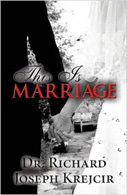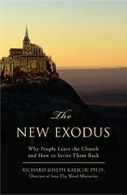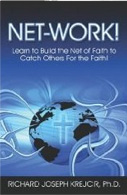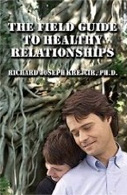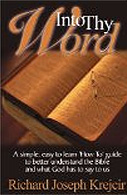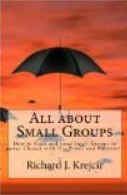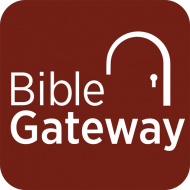The History of 'Doing Church' through the centuries
Well, there is a reason we do church the way most practice it today. There are essential patterns, rooted in the Old Testament, that God requires so we can respond to and give honor to Him. These patterns, practiced by the early church, have evolved into what we have today.
The Time of the Patriarchs
Before the Exodus, the Hebrew people worshiped God, following a simple pattern of praising Him, providing Him sacrifices, both of the farm animals and from the land with grain offerings (Gen. 4:3-5). Each family unit or clan held their worship as they saw fit. They had a fear of God (Gen. 2:3; Judg. 17:6; 21:25; Prov. 3:5), and knew it was a privilege to be able to be able to draw near to God the Creator. There was no real unity or formula that we know of, other than the praise, sacrifice, and petition, or, as we say today, supplication--seeking help from God. Supplications comprise 99% of our prayers today (not supposed to, but they do, we forget intercession, thanksgiving…etc.), and since human nature has not changed, due to our sinful nature, we can surmise it was the same then too. Perhaps Adam himself established a worship tradition that was followed through the centuries until Moses. We only get a taste of what might have happened through the first few chapters in Genesis, and our understanding of ancient Hebrew culture only comes through archeology, Scripture, Jewish tradition and writings.
After God established a covenant with Abraham (Gen. 12), he and the rest of the patriarchs worshiped God with sacrifices, singing, prayer, self-humbling confession of sin, then the retelling of God's promise and their special place as His chosen people. It was an awesome, special privilege to be allowed to worship the One True God. This pattern kept the Hebrews a close-knit family, and drew them together even during the persecution and turmoil while living in Egypt. In contrast, other ancient ethnic cultures, when faced with such adversity, either blended in with the dominant culture or disappeared. The Jews remained stable, set apart, and strong, and even grew through such tough times.
The Exodus
Then, a more specific model and framework was developed from the Mosaic Law, during, and polished after the Exodus. The primary model of worshiping God was due to a response to His provision and Grace. God laid out specific formulas on how He was to be worshiped; this is what the books, Leviticus, Numbers, and Deuteronomy, are all about.
The people are instructed on how to address and come before God, as well as how to deal with sin and human relationships. These new ways of worship were not so much new as they were expansions of what was already being done, cementing its urgency and importance. The new ways included a specific day, a unified way and place of doing a worship service, a Day of Atonement; and three feast days and rituals that formed the worship services and festivals.
Worship was then and still is now a means to honor God, glorify Him, and His good works, gifts, greatness, graciousness, mercy, judgment, power, instruction, and knowledge. The worship pointed to the coming of the Messiah Christ and what He would do. The main difference is the Christian worship today lifts up Christ, and what He has done, whereas the Jewish services of worship looked toward the coming of the Messiah--Christ. Thus, praise and thanksgiving were primary aspects in doing Church.
The major, striking similarities we have today with the Mosaic traditions are that the priests led the service as a large unified assembly. Even Sunday School finds its roots back then, as further instructions and teachings were carried out by the Levites (then, the Rabbis, during the captivity, in Jesus' time, and continued today) to the various tribes, clans, and families. Levites were assigned as teachers to family units who were to care and provide for them, while the Levite taught the Law.
The book of Psalms was and is the collected hymnal of the Jewish church service. Some of the Psalms date back to the Patriarchs, while others are new, written during the time of David and Solomon. They even included music notes for the worship leader. That is what the term, Selah, is!
The pattern of worship from the Law / Moses:
- The Sabbath, the seventh day of rest and worship. The Sabbath was instituted at creation. This started on Friday evening and went all day Saturday. This was done at the temple meeting (tent of the Ark) before the Temple of Solomon was built, and then in the temple of Solomon centuries later.
Since the people did not have cars, there were also synagogues in every town, where the Levites led the services. These synagogues were further developed during the Exile. After the Exile, the Sabbath became a day for worship and the study of the Law, as well as a day of rest. Each family unit would take a pilgrimage to the Temple in Jerusalem every so often, just as Jesus did as a child with His earthly family. The term Rabbi meant teacher (not necessary a Levite), and they led the service after the captivity, during the time of Christ, and to the present. (Gen. 1:1-2:3; Ex. 16:21-30; 20:8-11; 31:12-17; 34:21; 35:1-3; Lev. 19:3; 30; 23:3f; 58:13-14; Num. 15:32-36; Duet. 5:12-15; Isa. 58; 13-14; Luke 2:41-50)
The Christian church today as a whole recognizes Sunday as the Sabbath and day to do church because it is the day Jesus rose from the dead (the exception is the Seventh Day Adventists, the Seventh Day Baptists and some Christian Messianic groups such as Jews for Jesus). But, Scripture is clear that day now is irrelevant, pointing out that every day is a day to honor God and worship Him (Matt. 12:1-12; Rom. 12:1; Col. 2:16-23; Heb. 4:8-11).
- The Sacrificial System was the essential ritual that cleansed their sins. This is where burnt offering of animals, grains, and even baked goods were offered up to deal with their sin, and appeasing God's wrath. These sacrifices were personal purification and/or collective atonement for the town or the nation. They must be a true sacrifice, where the person would miss and lose out, suffer a loss, and give up any right to the item offered up to God. It must be pure, without blemish, and flawless. The entire universe is a testament to sacrifice, as the lamp's filament is sacrificing itself to give me light to write this article, and our sun burns its finite and limited fuel to warm our earth. All of creation and life is due to sacrifices of some kind. We may not see it; nevertheless, it is there. We need to acknowledge the importance of sacrifice, our Lord's sacrifice, and our hope to come (Ex. 13:1-16; Lev. 12-15; 17; Num. 19; 28:1-5).
In the church today, we may not have to drag the cat to the altar, or give up a valuable item, but we need to know that all things belong to God, and He provides for us. Christ is our perfect, flawless sacrifice who took our place to appease God's wrath and atone for our sins. Thus, He is the essential sacrificial Lamb, whose blood was shed for us.
- Annual Feasts. Three were held each year to honor God and His provisions, including the Passover (Ex. 23:14-17; 34:23; Duet. 16:16.) These were also known as the pilgrimage festivals, because people would travel by family and clan units, sometimes very far, by foot. The people gathered to offer sacrifices and praise God for the bounty they received from Him. It was a time of great joy, as well as humbleness in the knowledge that God, as the great provider, made them the recipients of His grace and mercy. It was also a time when they celebrated their deliverance. It pointed to how God reconciles Himself to humanity, ultimately, in the final recompense and reconciler to come, Christ.
- The Passover, otherwise called The Feast of Unleavened Bread, is celebrated because of God's mercy in sparing them when the Angel of death took out the entire first born of Egypt, humans as well as animals while he passed over the obedient Hebrews (Ex. 12; Lev. 23:5-8; Num. 28:16-25; Duet. 16:1-8). This was and is the biggest 'holiday' and festival, as it celebrated God's saving mercy shown through the exodus from oppression into the promise land. This was and still is celebrated the fourteenth day of the first month of the Jewish calendar, the month of Nisan (March/April).
- The Feast of Weeks, also called First Fruits, Harvests, and Pentecost, this was celebrated on the sixth day of the month of Sivan (May/June). The priest would offer up to the Lord by waving two loaves of leavened bread (made with yeast, versus unleavened made without yeast, for Passover), made from ripe grain that had just been harvested. The characteristic ritual of this feast was celebrated at the end of the grain harvest as thanks for the food, and was held (not celebrated much since, and perhaps before the time of Christ, but some orthodox groups still celebrate today) fifty days after the Passover. The term Pentecost, means fiftieth, because there was an interval of fifty days between Pentecost and Passover. (Ex. 23:16; 34:22; Lev. 23:15-22; Num. 28:26-31; Duet. 16:9-12). And it was on this feast day God chose to send His Spirit in permanence as recorded in Acts (Acts 2).
- The Feast of Tabernacles, or Booths, or Ingathering, this was celebrating how God led them through the desert for forty years, providing for them as He continues to do today. This was held in the seventh month of Tishri (Sept./Oct.), which celebrated the end of the agricultural year that began five days after the Day of Atonement and lasted seven days. It marked the end of the harvest, and also commemorated the Jews' forty-year wanderings in the desert.
During this festival, the Jews built and lived in booths or tents near the Temple/Tent Meeting in Jerusalem as a reminder of their ancestors, who wandered and lived in booths (The word, Hebrews meant wanderer). The sacrifices of this feast were usually more numerous than at any other festive day, since they had more with which to celebrate. It corresponds to our New Year's Day, and was celebrated from morning to evening while various types of horns and trumpets were blown. (Lev. 23:34-43; Num. 29:12-38; Duet. 16:13-15).
- The day of Atonement was the acknowledgement of sin, today called Yom Kippur. It was not a feast, but rather a fast, as the distinctive purpose of the this day was to bring the collective sins of the people for the whole preceding year to remembrance and confession before the people, so that it might earnestly be dealt with and then atoned for. Once a year the high priest would have the tribes gather on the tenth of the seventh month of Tishri, the tenth day (Sept.), where the high priest sacrificed an animal-- usually a red bull--and then spread the blood over the innermost part of the Tabernacle/Temple. The high priest then made the confession of all the sins of the Twelve Tribes, and entered, on their behalf, into the Most Holy Place with the blood of reconciliation. This was the only time the priest would venture into the inner part of the sanctuary where the Ark was kept. Then he placed his hands on a live goat to absorb all of the sins of the people. The scapegoat, as it was called, was let loose to atone for the sins of the people (Lev. 16; 23: 26-32).
Extra Biblical Feasts that were grafted in:
- The Feast of Lights, now called Chanukah, was observed for eight days beginning on the twenty-fifth day of Kislev (Nov./Dec.). The eight days were set aside to honor God for allowing the lamp to stay lit for those days, even though there was only enough oil for one. Judas Maccabeus initiated this feast in 164 B.C. when Epiphanes, the king of Syria, defiled the temple. During these days the Israelites met in their town's synagogue, carrying branches of trees in their hands (as they did to honor Jesus in Luke 19:28-40, what we now celebrate as Palm Sunday), and held jubilant services. Then the Temple was cleansed and rededicated to the service of the Lord. Children have been told about the brave deeds of the Maccabees for the last 2000 + years so that they might emulate their character. This was a very minor feat day that arose in popularity in Europe because is corresponds to the time of Christmas.
- The Feast of Purim was celebrated on the fourteenth and fifteenth days of Adar (Feb./Mar.) The word Purim means lots, as in casting lots or dice. This feast day recalls the time in Jewish history when the lot was cast to decide the day of destruction of the Jewish people and how God intervened so that this plan was not carried out. It was started by Mordecai to commemorate the failure of Haman's plots against the Jews. On the evening of the thirteenth, the whole Book of Esther was read publicly in the synagogue. It was a joyous occasion (Esther 9:20-22, 26-28). This day instills to us that, "Without faith, it is impossible to please Him."
Why were these Feast days and Atonements important? Because, they pointed to the sacrifice of our Lord on the cross to come!
Based on the Old Testament precepts, God has revealed His general truths to us:
1. God is a holy and jealous God, thus we are to honor and worship only Him. He has forbidden us to worship anyone or anything besides Him! Therefore, nothing should get in the way of our heartfelt devotion to Him, and His Lordship in our lives. That He is Lord and ruler of our hearts and mind not things, careers, friends, pride, agendas…
2. God has given us the proper pattern for worship. He calls us to honor Him in an orderly way. This is because our sinful nature will cause us to corrupt all that we do, including the worship of God. We do not have the right to take away any of His essential orders of worship. We cannot just do what we feel like and do church the way we think is best, or by what is popular; we must do what is acceptable and what honors Him!
3. God demands that we remove all of the false and corrupt manners of worship.
Now we are under the New Covenant.
You may think that since this is the Old Testament, it does not apply to us. The answer is both yes, and no. Yes, we do not need to follow the feast days, but we are to follow the pattern of worship that He has set up, and is confirmed in the New Testament. Christ is our supreme Priest, and the means of atonement. The cross supersedes the Law's requirements, but not the Law itself, because the Law points us to our depravity and need for our Savior (Heb. 7-10).
There are three major points distinguishing the New compared to the Old Testament practice of worship:
1. There is no longer a Temple; therefore there is no one or central place for worship. The Person and work of our Lord Jesus Christ have fulfilled the purposes of the Temple ordinances. There is no one true Church, as we have many denominations and churches that we can choose to go to.
2. Christ has also fulfilled the regulation that only the Levitical priesthood performs public worship. Today all Christians are priests in a sense as the doctrine the priesthood of all believers. God will call certain godly people to lead, the role of Pastor.
3. The church no longer needs to practice the sacrificial ordinances, as Christ is our supreme sacrifice.
4. The system of Sacraments or Ordinances (meaning the allegiance, or oath to the teaching of Christ that is sacred, His most important teachings) in traditional Christianity, and practiced by most Protestant and Catholic Churches, have replaced the Feast days and the Day of Atonement, circumcision, Passover, and sacrifices.
The sacraments are the specific things Christ told us to do (Mark 7:19; 1 Cor. 5:7-8; 11:23-26; Gal. 2:3-5; 4:10; 6:12-16; Col.2: 16; 1 Tim. 4:3-4). All denominations look to them as models of worship and practice in the church. They may disagree on how many (throughout church history, as many as thirty have been claimed. Catholics say seven, as they add penance, marriage, conformation or first communion, and the priesthood; most Protestants claim two or three, communion, baptism, and worship (some denominations do not consider worship as a sacrament). The Greek Orthodox adds the washing of feet. The Quakers and the Salvation Army do not practice any of the Sacraments, due to an overreaction to the abuses they observed of them in other denominations, while denominations such has many Baptist, Independent and Fundamental groups use the term Church Ordinances declaring them a ceremony. Most liturgical Denominations see the sacraments as a means of grace where Christ can minister His salvation through them such as the Catholics, Episcopalians and Lutherans.)
The Reformed view sees Sacraments as the term means the mystery of something sacred: A visible and tangible sign of God working in the elements lifted up to Him, such as the bread and water that show us the His promise of grace. However, the person still receives Grace by faith alone. In other liturgical Denominations the elements are sufficient to communicate God's grace. Just read the Scriptures listed next to the sacraments below and see for yourself what God's Word has to say. Salvation is NOT though the sacraments; they are the signposts of God working. Salvation is only by faith in Christ! We are still to respect the sacraments, adhere to them with honor and joyfully partake in them. We are also to guard that they do not get corrupted.
The Major Sacraments:
1. We are to Celebrate the Lord's Supper/Communion (Isa. 52:15; 53:12; Matt. 26:26-29; Mark 14:22-25; Luke 22:15-20; 1 Cor. 11:20-25) This was instituted by Jesus on the night before His Crucifixion. He told the Disciples that the cup of wine (most Protestants now use grape juice; however, the type of element is irrelevant to the obedience of the statute) represented His own blood, shed to establish a new covenant between God and humanity. The bread represents His body broken on our behalf. Thus, when the Lord's Supper is partaken we meet Christ and are made present with Him (Omnipresence of God) in remembrance of His atoning death and sacrifice on our behalf, and looks to the fullness of the Kingdom of God. As Calvin said, "we are given a taste of Heaven")
There is debate amongst denominations whether Christ is actually the elements of bread and wine (Catholic- transubstantiation), physically added in to the elements (consubstantiation- Lutherans), Christ is not physically present as His body is not there but in Heaven; however, He is still really present (Calvin-Reformed), or partially present or it is just a memorial (Zwingli-Baptists).
The Lord's Super also pointed toward consummation of the Kingdom of God. At first, the Communion was a part of a gathering for a meal in private homes (1 Cor. 11:17). Over time, it became a part of the Sunday worship of the local church. To the Catholics, this became the focal point of the service, observed toward the end. The first parts were the reading of the Word, prayers, singing of psalms/hymns, intercessions, and a homily (the Reformers switch to the sermon as the focal point).
2. We are to Baptize Believers and/or dedicate our children. The Reformed position allows for the baptism of infants as an identification to the circumcision covenant, which looks to their faith to come that becomes sealed when the person professes their faith as an adult. This also dedicates the child to the Lord and governs the responsibly of the parents and church to raise the child in a godly way. Then the child, when he/she becomes an adult, professes that faith publicly to fully receive the baptism they had as an infant. Adult baptism looks to the faith they already have accepted (Matt. 28:19).
3. We are to Worship God the first day of the week (Acts 20:7; 1 Cor. 16:2; Rev. 1:10). Because Christ rose from the dead that day, the service is to praise God, lift up the cross, and celebrate what He did for us.
Our Pattern for Worship
As we can see, the principle pattern of worship has existed from the beginning; it has been refined as humanity grew in understanding of God and as He revealed Himself to us. The standard church meeting we have today still has the original pattern that God instituted. We gather to worship through singing, prayer, liturgy, the reading of the Word, and a message/sermon/homily. Each denomination and individual church has added traditions of man in the mix. Hence, the various worship styles, orders, preaching, and building architectures. These minor differences need not be debated, as there are many ways to express our devotion and love to the Lord. The important thing is to honor Him in the proper pattern and essentials.
The intention of doing church remains steadfast for the most part. There are churches that are apostate and forget God and do their own thing. As a community of believers apart of the universal Church, and the bride of Christ, we are to follow the pattern that the Bible lays out. And, it should be the same through all denominations that acknowledge Christ as LORD.





